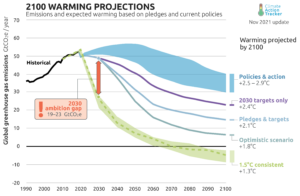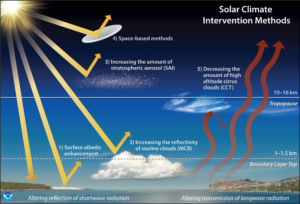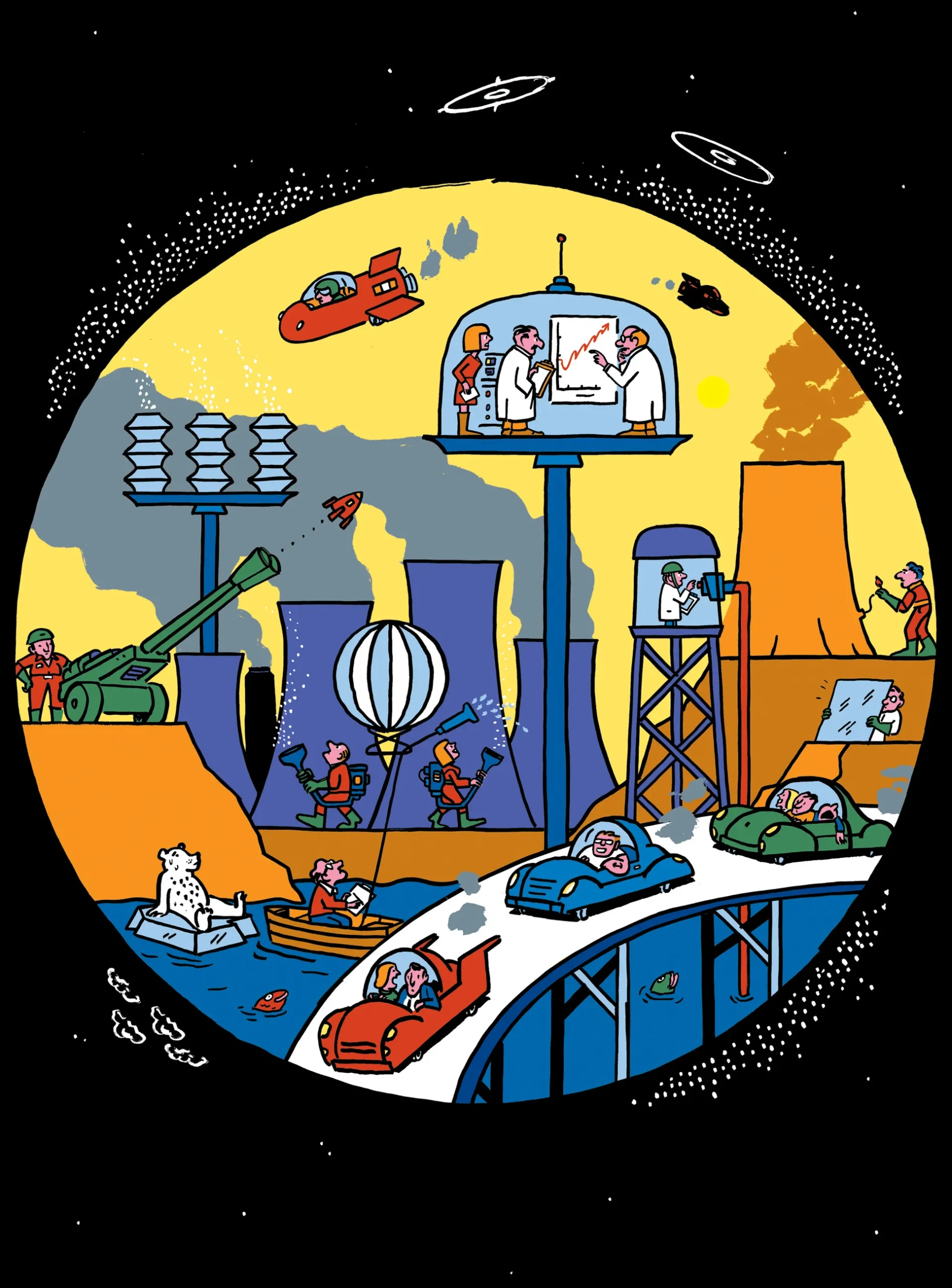blog post by Lukas Rieder
Dangerous anthropogenic climate change is already a reality on earth. Although the global-average near-surface air temperature has so far risen only about 1°C above its preindustrial value, significant harm to health, safety, economies, and ecosystems is already occurring. The international community of states tries to limit global warming through agreements made at the Conference of the parties (COP). The most significant success was reached in 2015 at the COP 21 in Paris, where a treaty was adopted by 196 Parties. The treaty has the ambitious goal to limit global warming to well below 2, preferably to 1.5°C, compared to preindustrial levels (UNFCCC, 2015). Unfortunately, since then, the annual carbon dioxide (CO2) and methane emissions just have risen with the tiny COVID 19 decrease for one year (Friedlingstein et al., 2022).

Furthermore, this huge amount of emissions is not expected to decline soon. According to the most recent update of the Climate Action Tracker (2021), under current policies presently in place around the world, we are on track to 2.7°C above preindustrial temperatures in the year 2100, see figure 1. The Hamburg Climate Futures Outlook also doubts the plausibility of deep decarbonization by 2050 , which would be in line with the 1.5°C target (Stammer et al.,2021).
For some scientists, the rapid greenhouse gas (GHG) emission reduction of our world to limit the temperature well below 2°C seems to be even impossible to reach in time. To avoid the dangerous impacts of climate change, they propose a more powerful approach to limit the global average near-surface temperature: Solar Geoengineering (SG). It is an entirely different approach to tackle climate change as it does not deal with the reduction of GHG emissions but the reflection of incoming solar radiation to compensate for a part of the radiative forcing (RF) caused by the GHGs. Solar Geoengineering is not mentioned at all in the IPCC AR6 WG3 Summary for Policymakers as it is a controversially discussed topic with a lot of risks and uncertainties. However, at Harvard, there are even thoughts about the governance of solar geoengineering deployment. The Harvard Project on Climate Agreements has released a volume of expert briefs that explores a range of topics related to how the deployment of solar radiation management can be controlled, see (Stavins and Stowe, 2019). It shows how crazy far we actually are already right now and is worth a closer look. An answer to the question of whether or not we should do SG is not the scope of this post. However, I provide the reader with a few arguments about it.

SG is generally considered because it offers a cheap and potentially powerful tool to cool down the global near-surface air temperature (Wagner and Weitzman, 2012). The most prominent approach under the Solar geoengineering framework is the stratospheric aerosol injection (SAI), see figure 2. This can offset up to half of the RF from a doubling of CO2 concentrations (around 2 Wm-2) with high confidence. However, this is a substantial intervention in the climate system, which will have side effects. Perturbation of precipitation patterns is one of the most severe know downsides. Climate Modelling experiments show a small global decrease in precipitation with more considerable anomalies on regional scales, thereby having an impact on the global crop yields and drinking water supply. The injection must also be maintained as long as there is an excess of GHG in the atmosphere. Once stopping, the climate system will rapidly heat up and equilibrate with temperatures consistent with the higher GHG concentrations (Boucher et al., 2013). Furthermore, the SG might lead to biodiversity loss and other unanticipated side effects (National Research Council, 2015). Overall it is a risk of climate change against the risk of Solar Geoengineering decision whether to or not to deploy it. That decision shows the dilemma of this technology. Now, as we have not yet reached our own set temperature thresholds, we still have the chance to decide to opt for real Mitigation of Emissions and thereby not run into this dilemma. It tackles the real cause of the problem instead of its effects on global temperature, thereby avoiding other issues like ocean acidification. But from a certain point in the future, on a high emission pathway, the dangerous impacts of climate change might outweigh the risks of Solar Radiation Management.
Thus in my point of view, we should not wholly discard the research on Solar Geoengineering. Nevertheless, concerns about crowding out must be taken into account since some actors will surely use Solar Geoengineering as yet another excuse to delay necessary emission reductions. Finally the research on Solar Geoengineering should be a wake up call for everybody to understand how severe climate change is.
References
Boucher, Olivier et al. (2013). “Clouds and aerosols”. In: Climate change 2013: the physical science basis. Contribution of Working Group I to the Fifth Assessment Report of the Intergovernmental Panel on Climate Change. Cambridge University Press, pp. 571–657.
Council, National Research (2015). Climate Intervention: Reflecting Sunlight to Cool Earth. Washington, DC: The National Academies Press. isbn: 978-0-309-31482-4. doi: 10 . 17226 / 18988. url: https://nap.nationalacademies.org/catalog/18988/climate-intervention-reflecting-sunlight-to-cool-earth.
Friedlingstein, P. et al. (2022). “Global Carbon Budget 2021”. In: Earth System Science Data 14.4, pp. 1917–2005. doi: 10 . 5194 / essd – 14 – 1917 – 2022. url: https://essd.copernicus.org/articles/14/1917/2022/.
Stammer, Detlef et al. (2021). “Hamburg climate futures outlook 2021: assessing the plausibility of deep decarbonization by 2050”. In.
Stavins, Robert N and Robert C Stowe (2019). “Governance of the deployment of solar geoengineering”. In: Cambridge: Harvard Project on Climate Agreements.
Climate Action Tracker (2021). 2100 Warming Projections Emissions and expected warming based on pledges and current policies. https://climateactiontracker.org/global/temperatures/.
UNFCCC (Dec. 12, 2015). Paris Agreement. UNTC XXVII 7.d (legally binding international treaty on climate change). url: https://unfccc.int/process/conferences/pastconferences/paris-climate-change-conference-november-2015/paris-agreement.
Wagner, Gernot and Martin L. Weitzman (Oct. 2012). Playing God. url: https://foreignpolicy.com/2012/10/24/playing-go
Thmson, Chelsea (2021). NOAA/CIRES , url: https://research.noaa.gov/News/Scientist-Profile/ArtMID/536/ArticleID/2756/Simulated-geoengineering-evaluation-cooler-planet-but-with-side-effects


Thanks for bringing up this timely and controversial topic.
Recent must-reads on this topic include
https://www.matteringpress.org/books/engineering-the-climate (OA)
https://www.routledge.com/Imagining-Climate-Engineering-Dreaming-of-the-Designer-Climate/Oomen/p/book/9780367489311
These books show how looking at the history of a topic may inform our thinking about its future politics.
thank you for the additional resources